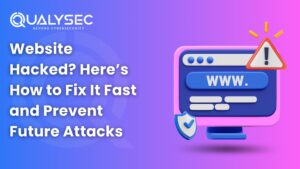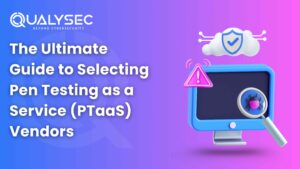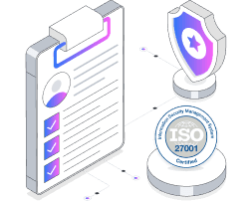-
Feature Item 1
Lorem ipsum dolor sit amet, consectetur adipisi cing elit, sed do eiusmod tempor incididunt ut abore et dolore magna
-
Feature Item 2
Lorem ipsum dolor sit amet, consectetur adipisi cing elit, sed do eiusmod tempor incididunt ut abore et dolore magna
-
Feature Item 3
Lorem ipsum dolor sit amet, consectetur adipisi cing elit, sed do eiusmod tempor incididunt ut abore et dolore magna

Top 10 Cybersecurity Leaders in Qatar 2025
Did you know that Qatar has been credited as a “Role-Model” country in the Global Cybersecurity Index 2024? That’s a huge win for the country, implying that it has secured top status by offering exceptional performance across different cybersecurity pillars. This accreditation reflects Qatar’s accelerating cybersecurity market and needs. As regulations become severe and cyber frauds increase, opting for a trusted cyber security provider in Qatar becomes essential. Whether you are a CISO overseeing government infrastructure or a startup prepping for ISO 27001 audits, choosing the most reliable cybersecurity leaders in Qatar for 2025 is critical. That is why we have curated a list of the top 10 cybersecurity leaders in Qatar. Here, you will find detailed information on the company, their website, and the services they offer. Each profile is fact-checked and presented with clarity, so you can quickly identify the vendor that matches your compliance needs & technical profile. Top 10 Cybersecurity Leaders in Qatar 2025 1. Qualysec About Us: Qualysec is an expert penetration testing and vulnerability assessment firm founded in 2020. Though headquartered in India, its global delivery includes structured support for Qatar-based organizations. We specialize in web, mobile, API, cloud, and IoT testing. Our experts deliver reports mapped directly to compliance requirements such as NCSA, ISO 27001, GDPR, HIPAA, and PCI DSS. We ensure the reports are developer-friendly and combined with replication steps and remediation suggestions, making us a leading cyber security provider in Qatar. Though the company is situated in India, our operating model is remote, coordinated via teams aligned with Doha business hours and communication cadence. Location: Serving clients Globaly Services Offered: Qualysec provides a comprehensive suite of technical security testing services focused on identifying, validating, and helping remediate vulnerabilities across modern digital infrastructures. Our core offering is penetration testing, conducted manually by security experts following different industry standards. This includes testing for critical issues such as injection flaws, broken authentication, insecure deserialization, and logic vulnerabilities in web applications, mobile apps (iOS & Android), and APIs (REST, SOAP, GraphQL). Looking for a compliance pen testing partner in Qatar? Talk with our experts today! Latest Penetration Testing Report Download 2. Factosecure About Us: Factosecure is a Qatar-based cybersecurity consulting and services firm specialising in risk-based governance, compliance auditing, and technical assessments. It caters predominantly to enterprises and public institutions seeking tailored risk strategies within Qatar’s regulatory framework. Their strong alignment with Qatar’s national cyber governance structure makes them ideal for regulatory-heavy industries like banking, energy, and education. Location: Doha, Qatar Services Offered: Managed security services Application and cloud security Network and endpoint security Security assessment and compliance Identity and access management Incident response 3. Microminder Cyber Security About Us: Microminder is a reliable cybersecurity leader in Qatar, with a global presence. For Qatar clients, they offer hybrid delivery of offensive security, security awareness training, and endpoint protection. They’ve worked with clients across healthcare, education, and mid-sized tech companies in need of managed security operations. Location: Service coverage in Qatar via global operations Services Offered: Penetration testing and red teaming Security operations center (SOC) Endpoint detection and response (EDR/XDR) Compliance consulting Cloud security solutions Zero trust security 4. Wattlecorp Cybersecurity About Us: Wattlecorp focuses on DevSecOps-driven cybersecurity services for agile teams, startups, and enterprise developers, making it a trusted cybersecurity company in Qatar. They emphasize security as a development enabler, offering early-stage threat modeling and sprint-integrated pentesting. They deliver explicit alignment with the local tech ecosystem. Location: Doha, Qatar Services Offered: Vulnerability assessment Penetration testing Qatar Cybersecurity risk and compliance consulting Managed security services Cyber hygiene audits 5. HIT Cybersecurity About Us: HIT Cybersecurity offers a mix of IT infrastructure, managed cybersecurity, and digital transformation services, making it a well-known cyber security pentesting company in Qatar. Their cybersecurity unit focuses on endpoint security, threat detection, and regulatory compliance for Qatar’s mid-sized businesses. As this company offers comprehensive IT and cyber services, it is ideal for businesses modernizing both their tech and their security stack. Location: Doha, Qatar Services Offered: Vulnerability assessment and pentesting services IT governance and risk compliance Data privacy and protection OT/ICS/IoT Cyber Security 6. Barikat Cyber Security About Us: Barikat Cyber Security is a well-established top cyber security vendor in Qatar, offering consulting and implementation services across network security, SOC, and data protection. Their expert team provides hands-on deployment of cybersecurity architecture, especially for infrastructure-heavy sectors. Location: Doha, Qatar Services Offered: SOC as a service Penetration testing Incident response Governance and compliance 7. Al Maliky Information Technology About Us: AMITS is a top-rated IT & cyber security solution provider in Qatar offering cybersecurity solutions alongside traditional infrastructure support. Their security offerings focus on access control, surveillance integration, and data protection. Location: Doha, Qatar Services Offered: IT service management Endpoint and data security Network and application security Disaster recovery Cloud and mobile security 8. Secneural About Us: Secneural provides expert cyber security solutions with a focus on threat detection and SOC automation. Their platform offers behaviour-based analytics that are tailored for GCC threat vectors and compliance mandates. With a solid multi-funnel framework, Secneural has emerged as one of the most reliable cyber security leaders in Qatar. Location: Doha, Qatar Services Offered: Vulnerability assessment and penetration testing Incident response Compromise assessment Security products assurance testing Cyber attack drills IT GRC 9. TechSpine About Us: TechSpine provides managed cybersecurity services and IT consulting for small to mid-sized businesses in Qatar. Their strength lies in affordable solutions paired with responsive local support, making them a highly popular cyber security provider in Qatar. Location: Doha, Qatar Services Offered: Compliance and risk management consulting Vulnerability assessment Manual and automated testing Managed security services 10. Integra Security Services About Us: Integra Security Services delivers full-stack IT and cyber infrastructure projects with an emphasis on corporate networks, endpoint protection, and secure architecture design. They’re known for integrating vendor products

Top 10 Cybersecurity Service Providers in South Korea
As digital threats are on the rise every day, the importance of cybersecurity cannot be underestimated, especially in a highly connected country like South Korea. Strong cybersecurity efforts are required from everyone, from local and national businesses to global companies, to protect data, systems, and privacy when conducting business or sharing information. Fortunately, South Korea has many trusted cybersecurity company that offer organisations options to protect their information. In this blog, we will provide the Top 10 Cybersecurity Service Providers in South Korea, starting with the leading name Qualysec. List of Top 10 Cybersecurity Service Providers in South Korea South Korea is one of the most digitally advanced countries in the world, and that comes with a need for strong cybersecurity. From big enterprises to tech start-ups, every organization needs to protect its data and systems from rising cybersecurity threats. In this blog, we have listed the top 10 cybersecurity service providers in South Korea who are taking care of businesses. 1. Qualysec Qualysec is one of the fastest-growing cybersecurity companies and has rapidly gained a strong reputation in South Korea for its expert-led security testing and consulting services. It believes in helping organizations locate vulnerabilities and fix them before they can be exploited by cyber attackers. This is known for its professionalism, using automated tools when applicable and manual testing when necessary. Whether you are a startup, small to midsize business, or enterprise-level business, Qualysec’s team will ensure that your applications, networks, and systems are fully secured and compliant with industry standards. It’s long-established, global offices and clients consist of a growing number of happy customers from different sectors. Whether in fintech, healthcare, SaaS, or government services, Qualysec is trusted by businesses in every sector. One thing that clients have mentioned that sets Qualysec apart is its transparency, full-scope reporting, and post-assessment support, which makes it a strong cybersecurity partner in the region. Why It Stands Out: Website: https://www.qualysec.com Location: Bhubaneswar, India (Global service delivery including South Korea) Services Offered: Secure Your Business Before Hackers Do – Book a Free Consultation! 2. AhnLab AhnLab began in South Korea and is a major player in the cybersecurity space. They provide a full suite of services, including antivirus software, endpoint protection, and cloud security. Their product, V3 Internet Security, is widely used by individuals and enterprises alike. In addition to consumer products, AhnLab develops advanced threat intelligence and network monitoring solutions to mitigate cyberattacks. They continue to invest in research and development innovation, positioning them to respond to new threats. With more than 25 years of experience, AhnLab has been enlisted by many South Korean enterprises. Why It Stands Out: Location: Seongnam-si, Gyeonggi-do, South Korea Services Offered: 3. Penta Security Penta Security is a leading web application firewall, data encryption, and cloud security provider. They are based in Seoul and focus on securing web applications and databases and protecting networks for enterprise clients from potential cyberattacks. Their product WAPPLES is one of the leading solutions in the web security arena. Penta Security is also doing work on IoT and blockchain security solutions- a chance for businesses to advance their technology in a safe place. Penta Security has a robust research and development team and a customer-first philosophy. They remain one of the foremost trusted cybersecurity providers in Asia. Why It Stands Out: Location: Seoul, South Korea Services Offered: 4. EST Security EST Security provides a full range of Cybersecurity Service Providers in South Korea in from anti-malware to endpoint and cloud solutions, catering to both small businesses as well as large enterprise customers. Part of their offerings includes ALYac, a well-known antivirus tool widely used in the business world. They also focus on APT (Advanced Persistent Threat) defence, utilizing AI and machine learning to detect sophisticated attacks, in addition to their typical offerings of security and compliance resources. EST Security supports an aggressive product development approach and updates to beat the compromises and provide strong customer service, compliance, and systems of record features to keep users secure while being under attack. Why It Stands Out: Location: Seoul, South Korea Services Offered: 5. INCA Internet (nProtect) INCA Internet, primarily known for its nProtect products, provides Cybersecurity pentesting service for the financial, e-commerce, and gaming industries. Their products and solutions have been used widely to protect users from malware, phishing, and fraud. They offer endpoint security, server, and mobile security products. INCA Internet’s leading area is having a wide range of understanding of specific threats in the industry. It is previously known that many investment and financial institutions and online gaming operations in South Korea believe certain brands and their data are trusted for security. Why It Stands Out: Location: Seoul, South Korea Services Offered: Your App Deserves Bulletproof Security – Get Started with Us. 6. MONITORAPP MONITORAPP and its cloud-based security division, AIONCLOUD, are committed to providing cloud-based cybersecurity solutions. Services include Web Application Firewalls (WAF), Email Security, and a Cloud Access Security Broker (CASB). AIONCLOUD is particularly well-suited for organizations that plan to use an abundance of cloud services and desire flexible security. All of the tools are user-friendly and suitable for today’s cloud-first environments, with centralized control and real-time monitoring. Why It Stands Out: Location: Seoul, South Korea Services Offered: 7. IGLOO Security IGLOO Security is a leader in Security Information and Event Management (SIEM). They support security operations, incident response, and threat intelligence, and their primary product, SPiDER TM, allows organizations to identify, analyze, and respond to threats in real-time. They also perform much of that work as consulting and system integrators to help organizations build their own Security Operation Centers (SOC). IGLOO is unique in that it focuses R&D on developing unique customized security solutions for its clients in the finance, telecom, and public sectors. Why It Stands Out: Location: Seoul, South Korea Services Offered: 8. CyberSafeHaven Consulting CyberSafeHaven Consulting aims to help businesses build stronger security systems. They provide cyber security as a service, vulnerability assessments, and cyber defence planning. They primarily focus on midsize to

Top 30 Cybersecurity companies in Germany (2025)
Germany boasts a vibrant cybersecurity industry and many companies are paving the way to protect domestic and foreign markets from ever-evolving cyber threats. German cybersecurity companies are a diverse group of organizations that range from technology giants, to established companies, and startups and have established themselves at the forefront of protection against cybercrime. Here is a guide to the 30 best cybersecurity companies in Germany, providing unique solutions for securing a digital infrastructure. Top 30 Cyber Security companies in Germany Germany is one of the leading centres for innovation in Europe around cybersecurity, with a strong blend of homegrown specialists and global giants. As cyber threats continue to multiply, businesses of all types and sizes are looking toward trusted providers of cybersecurity solutions to protect their data and infrastructure. German-based cybersecurity service provider are delivering market-leading services, from endpoint protection to cloud security, and penetration testing. This time around, we have included a summary of the top 30 German-based cybersecurity companies that are shaping the future of digital security. 1. Qualysec Qualysec is a developing cybersecurity firm increasingly gaining traction in Germany, particularly within penetration testing and vulnerability assessment services. Their company provides manual and automated security testing services for web apps, mobile apps, APIs, and networks. The most important aspect of Qualysec is their consulting-driven offering that gives close attention to how organisations can fix the underlying issues rather than leaving them with a report. Their security audits are based on good compliance with global compliance standards like OWASP, ISO 27001, GDPR, and SOC2 and their client-focused processes along with substantial remediation support have made them a trusted supplier for startups and enterprises wanting genuine actionable security. Their growing reputation across Europe has been driven by their ability to provide deep, technical subject matter knowledge with quick turnaround time. Download our Sample Penetration Testing Report to understand how vulnerabilities are reported and mitigated. Latest Penetration Testing Report Download 2. Secunet Based in Germany, Secunet is a player in the highest order within the German cyber security market and provides IT infrastructure and services that are highly secure. They are focused on defending critical information technology systems, including government IT, defence IT and banking IT. Their flagship product the SINA platform enables secure communication and is being widely trusted by organizations that require secure and safe digital transactions and operations to protect sensitive information. 3. Utimaco Utimaco specializes in hardware security modules (HSM) and provides solutions for data encryption and tokenization. As a pioneer in ensuring sensitive information is always secured and protected, their products are utilized in banking, telecommunications, e-government and business all around the world. Their experience in meeting compliance and protecting digital assets places them firmly as a leader within the cybersecurity companies in Germany. 4. Hornetsecurity Hornetsecurity is known for its advanced email security solutions. It has products that defend against spam, phishing, malware, and a range of other email-based attacks, Hornetsecurity offers enterprises of all sizes complete undivided email security. The cloud-based services are available to minimize exposure to dangers while keeping the lines of communication open. 5. G Data Software G Data is one of the oldest and most established cybersecurity companies in Germany. While only popular for its antivirus and endpoint protection solutions, G Data does provide effective defences against different cyber threats. Their products are available for both individual users and enterprises and offer total malware, ransomware, and phishing protection. 6. Avira Avira provides a comprehensive set of cybersecurity solutions in antivirus software, VPN services, and system optimization tools. This cyber firm has a strong reputation for protecting personal data and is used by millions of people around the world. Avira also provides solutions for businesses and enterprise-grade security with data protection and privacy. 7. Tanium Tanium is a global provider of endpoint security and management and was founded in San Francisco. This cyber security top companies provides a platform that helps businesses quickly detect and respond to cyber threats across large and complex networks. Tanium’s enterprise endpoint security provides visibility and control of endpoints in real-time, which enables companies to protect against advanced persistent threat (APT) attacks and other serious risks. 8. F-Secure F-Secure is a cybersecurity company from Finland that has a presence in Germany. This cyber security services company offers next-generation cybersecurity solutions including endpoint protection, threat intelligence, and advanced malware analysis tools. F-Secure is well known for its innovative approaches to addressing cybercrime, including ransomware and zero-day vulnerabilities. 9. Deep Instinct Deep Instinct offers real-time predictions, ratings, and prevention of cyber threats with its deep learning technology. Cyber security firm Deep Instinct protects against various attacks such as ransomware, advanced persistent threats, and fileless malware. Machine learning for Deep Instinct enables highly effective, proactive protection for organizations. 10. Panda Security Panda Security, now part of WatchGuard, offers next-generate antivirus solutions for businesses throughout Germany. Their cloud-based services provide real-time protection from a wide variety of cyber threats such as malware, phishing, and ransomware. Panda’s centrally managed resources allow IT teams complete visibility into their networks’ security. 11. Infodas Infodas offers cutting-edge IT security solutions that meet the demands of government agencies, defence, and enterprises. Their offers include secure communication systems, data and user protection, and vulnerability assessments. Infodas and their solutions are known for their critical infrastructure, where safety and security are most important. 12. F5 Networks F5 Networks is a global cybersecurity behemoth with a significant installation footprint in Germany. The information security company is known for their application delivery controllers (ADCs) and their application security solutions that provide both optimization and security to web applications for enterprises and government entities. Their application security solutions protect applications in a way that even if a cyberattack occurs, the application maintains resiliency, remains secure and performs optimally. 13. Cisco Cisco is a global leader in both networking and cybersecurity. In Germany, Cisco is a major player in the security market. Their security solutions,

Website Hacked? Here’s How to Fix It Fast and Prevent Future Attacks
Searching Google using the phrase “Fix Hacked Website,” chances are you are not alone. Hacking of websites constitutes a global pandemic as it affects sites of small businesses as well as giant e-commerce websites. Every 39 seconds, cyberattacks are staged on average in 2025, and downtimes of an hour or two may leave thousands of dollars and reputational losses. You can be running a WordPress store, SaaS site, or a business site; being able to restore quickly can be the difference between life and death. This article will guide you through all you need to know about fixing hacked websites, a step-by-step process of recovery, and how to avoid future hacking with professional remedies such as penetration testing. Signs Your Website Is Hacked The problem with a compromised site is not raised in a high voice. The majority of the indicators are usually slight before it is too late. The most common red flags that your site has been breached are the following: And now, in case you are experiencing the listed symptoms and wondering what to do when my website is hacked, the initial action is to relax. The earlier you are sure about the problem, the earlier you can rectify it, and that is precisely what the next section will walk you through. Step-by-Step Guide to Fix a Hacked Website When your website is compromised, an immediate response can help avoid further compromise. These are the steps to safely and efficiently recover: 1. Remove Your Site from the Online Environment Temporarily Put your site into maintenance mode or shut down access to avoid further damage and stealing of data theft while you’re investigating. 2. Alert Your Hosting Provider Most hosting companies have incident response processes. They may assist in isolating the breach and provide logs or backups. 3. Scan for Malware and Backdoors Use trusted tools like Sucuri SiteCheck, Wordfence, or Quttera to detect injected code, malicious scripts, and vulnerable files. 4. Remove Malware and Clean Files Manually or with tools, remove infected files, rogue admin users, and suspicious code. Avoid restoring a backup unless you’re sure it’s clean. 5. Update Everything Update your CMS, themes, plugins, and third-party extensions to patch vulnerabilities that hackers might have used. 6. Change All Passwords Change passwords for your hosting account, CMS admin, FTP, databases, and email accounts used by the site. 7. Verify User Roles and Access Logs Only grant access to approved individuals. Check logs to trace how the attack occurred and when it took place. 8. Re-submit to Google for Review If your site was blacklisted, appeal for a review through Google Search Console after cleaning to regain your SEO credibility. Need professional assistance to clean and secure your website quickly? Employ a penetration testing company such as QualySec to detect vulnerabilities and fix them before hackers can use them again. Hire a Penetration Testing Vendor (Like QualySec) When you do not know how your site was hacked or you cannot be certain that your site is really clean, then the next thing to do is to hire a penetration testing company. QualySec is an expert VAPT (Vulnerability Assessment and Penetration Testing) company that specialized in exposing security holes and executing real life cyberattacks to detect weaknesses in advance before malicious users. The team of certified ethical hackers provides: Not sure how the attack happened? That is where a company like QualySec comes in — to locate where the breach occurred, how it happened, and to give you a comprehensive picture of how you can avoid repeating the same thing. Find out how QualySec can assist you to restore your site and protect it. Also read: How to Choose the Right Security Testing Service Provider for Your Business? Why Hire Professionals Like QualySec? Recovering a hacked site is not only about recovering, but it is also about ensuring debugging. And that is where cybersecurity specialists such as QualySec stand in. This is the reason why collaborating with them can make a difference: If your website has already been compromised, acting fast is important. Acting smart is what prevents the next attack. Post-Recovery Actions After cleaning and restoring your site, it is essential to make your defenses tighter. This is what transpires after that: 1. Publish and submit to Google In case your site was flagged or blacklisted then you need to log-in Google search Console and ask security review to make it visible. 2. Implement Web Application Firewall (WAF) Use a WAF such as Cloudflare or Sucuri to directly block suspicious traffic and guard against future attacks. 3. Allow Backups per Day Set up automatic backup in a safe place. This will allow you to start afresh in case of other breakage, so that you are able to recover faster. 4. Timely Monitor Your Site Monitor performance, changes, and threats in real-time using tools such as UptimeRobot, Wordfence, or Patchstack. 5. Make a Regular Penetration Test Schedule The next attack is not to be waited for. Pay professionals to perform VAPT testing on a regular basis so that weaknesses are revealed ahead of the bad guys. Latest Penetration Testing Report Download Conclusion A website hack is not simple to recover by removing questionable files or restoring a backup. It is a reminder to do more adequate digital hygiene and a sturdier infrastructure. A damaged site may cause data leaks, mistrust of clients, Google penalties, and even prosecution, in case personal or financial information has been compromised. Regardless of whether you have a small blog, a medium-sized ecommerce store, or a platform like an enterprise, the procedure that should help you fix hacked website issues should be combined with quick action and technical expertise, with a long-term strategy. It is not only the issue of stopping the leak, but also needs to comprehend how the hack was possible, repair the holes, and make sure that it will never happen again. And therein come experienced cybersecurity experts such as QualySec. Knowing how your site was hacked, up to

Top 20 Cybersecurity Companies in Denver
Denver’s booming technology and innovation sectors are drawing national attention. However, that also makes the city a prime target for cyber threats and malicious attacks. As per Kiteworks analysis, Colorado has a risk score of 7.96, making it one of the most vulnerable states in the US for cyberattacks. The state has witnessed a 58.7% surge in financial losses since 2017. That is exactly why businesses must choose a reliable and efficient cybersecurity firm in Denver. It is no longer an option or a “nice to have” thought for businesses operating here – choosing the best cybersecurity company is critical. In this blog, we list the top 20 cybersecurity companies in Denver. Each profile offers detailed information about the location, the services they offer, and their websites. That way, you can confidently map your security needs to the right partner. Protect Your Digital Assets Before It’s Too Late – Talk to Us Now. Top 20 Cybersecurity Companies in Denver 1. Qualysec About: Qualysec is a leading cybersecurity firm in Denver offering comprehensive penetration testing and vulnerability assessment services across cloud, web, API, mobile, and IoT environments. Their deliverables align with U.S. frameworks like HIPAA, SOC 2, and PCI DSS, with detailed reports of pen testing. Based in Bhubaneswar, India, Qualysec has successfully completed over 600 security assessments for 150+ clients across 21+ countries. This cybersecurity agency focuses on delivering precise and compliance-ready security solutions tailored to various industries, including healthcare, fintech, e-commerce, automotive, telecommunication, and more. Process-driven methodology and thorough manual verification make Qualysec stand out for its dedication to producing zero false positives. Owing to the client-centric methodology, each penetration test and security audit is customized to the client’s unique business model, technology stack, and compliance requirements. Higher relevance, useful insights, and quicker remediation are the results the client gets. Their extensive proficiency in manual penetration testing is one of their most notable qualities; this is an essential element that is frequently absent from scan-heavy or automated testing. That makes Qyalysec a desirable choice for companies looking for a trustworthy cybersecurity firm in Denver. Location: Serving clients worldwide Website: qualysec.com Services Offered: Note: To know more or avail our services, get in touch with our experts today! Talk to our Cybersecurity Expert to discuss your specific needs and how we can help your business. Schedule a Call 2. Datadog About: Datadog has evolved into a DevSecOps-native security platform, making it a highly popular cyber security agency in Denver. It integrates security monitoring, Cloud SIEM, App/API protection, and infrastructure scanning. This company is perfect for businesses wanting security and operations unified in one dashboard. Location: Global delivery to Denver (no physical office) Services Offered: Security monitoring Red Hat OpenShift Google Cloud Monitoring Compliance and Cloud SIEM SAST & IAST 3. Accedere About: Accedere is a Colorado-based CPA and cybersecurity firm in Denver known for its technical prowess. They offer SOC 1/2/3 attestation, ISO certification, cloud security assessments, VAPT, along with SCADA/OT evaluations. The firm specializes in blending audit-grade credentials with hands-on technical testing. Location: Denver, CO Services Offered: SOC audits ISO/IEC certification Cloud and pen testing CSOC services Vulnerability assessments 4. Red Canary About: Red Canary is a leading 24/7 Managed Detection & Response (MDR) company. It focuses on threat detection across endpoints, cloud systems, identities, and SaaS, making it a well-sought cyber security company in Denver. Location: Denver, CO Services Offered: MDR Threat intelligence Automated alerting Expert response for endpoints Security data lake Let’s Build a Safer Digital Future for Your Business, Contact us today. 5. Dirsec About: Based in Louisville, CO, DirSec is a well-known cybersecurity firm. They resell over 30 security products, provide penetration testing, cloud and network audits, vCISO, and managed services. Location: Louisville, CO (but supports clients on-site and remote in Denver) Services Offered: Pen testing Compliance audits Managed security services Cloud data security Network protection Firewall implementation & optimization 6. EPAM About: EPAM is a global digital transformation and software engineering firm with a dedicated cybersecurity practice. Their engineering-led approach offers services including threat modeling, DevSecOps integration, and managed security. Location: Denver, CO Services Offered: Cloud and data security DevOps Ransomware protection Zero trust implementation Managed detection & response 7. K3 Technology About: K3 Technology is a well-known cybersecurity firm in Denver, delivering managed cybersecurity solutions tailored for small and mid-sized businesses. They focus on proactive monitoring, endpoint protection, and secure cloud adoption. Location: Denver, CO Services Offered: Email security IT compliance Security assessments Office 365 optimization 8. Sekurno About: Sekurno is a leading cyber security agency in Denver specializing in compliance-driven testing and consulting. They deliver penetration testing, risk assessments, and ongoing security advice for regulated industries. Location: Denver, CO Services Offered: Web application testing Penetration testing Security risk assessments Compliance consulting (SOC2 Type I/II, DORA, GDPR) Source code review 9. Foresite About: Foresite provides strategic IT and cybersecurity consulting to mid-market companies in Denver. Their services focus on data protection, risk management, and alignment with frameworks such as NIST and ISO 27001. Location: Denver, CO Services Offered: Risk and compliance assessments EDR Firewall management Google cloud security Vulnerability & patch management 10. NewPush About: NewPush is one of the most reliable IT agencies offering managed cybersecurity alongside web and mobile app development. They pair pentesting and monitoring with tooling rollouts and incident response planning, making them a highly popular cyber security vendor in Denver. Location: Denver, CO Services Offered: Vulnerability management Threat hunting Managed detection and response Incident response Zero trust security 11. Envision IT Partners About: Envision IT Partners is a Colorado-based managed IT and cybersecurity provider founded in 2003. They offer enterprise-grade secure IT infrastructure tailored for SMBs, featuring proactive cyber risk monitoring and solutions Location: Denver, CO Services Offered: Managed 24×7 SOC and SIEM Firewall and antivirus deployment Application infrastructure solutions Zero trust security Compliance support 12. CP Cyber About: With headquarters in Denver, CP Cyber is a leading cybersecurity consulting firm specializing in

The Ultimate Guide to Selecting Pen Testing as a Service (PTaaS) Vendors in 2025
Cyberattacks are increasingly becoming even more frequent and expensive. Based on studies, the worldwide average cost of a data breach has hit the mark of 4.45 million at 15 percent higher than three years before. Businesses can no longer afford reactive security. That’s why Pen Testing as a Service vendors (PTaaS) are now central to modern cybersecurity strategies. In contrast to the concept of traditional penetration testing, PTaaS will operate in an on-demand, scalable, and automated testing that will be built into your CI/CD pipelines. This facilitates easier identification, prioritization, and remediation of vulnerabilities development and security teams by the developer and security team so that the vulnerabilities do not get exploited by attackers. As a fintech start-up creating reliable APIs or a health care provider concerned with HIPAA, it is important to choose the right partner in pentesting as a service that will ensure your firm can stay resilient and keep in line with the policies. Which penetration test as a service will suit you? We can help you get one that best suits your requirements and security maturity. What is Pen Testing as a Service (PTaaS)? And how is it Different? Pen Testing as a Service (PTaaS) has become an innovative solution to penetration testing as its combination of close industry-level guidance and security testing and allowance of cloud-scale solutions leads to high levels of flexibility and aids in rounding up the security testing. In contrast to the prevailing system of regular but infrequent pen tests, usually happening once or twice per year and in the form of a static report, platforms that incorporate PTaaS are accessible on a more permanent basis, run testing cycles more frequently, and provide real-time remediation information. Check out: Penetration Testing Tools Key Differences Between Traditional Pen Testing and PTaaS: Traditional Pen Testing PTaaS Conducted annually or biannually On-demand and continuous testing Static PDF reports Interactive dashboards with real-time updates Limited developer visibility Seamless DevSecOps integration Manual coordination and scheduling Self-serve test requests via the platform No real-time remediation support Live collaboration with testers and fix suggestions Testing is not the only feature of PTaaS companies because they also provide transparency, scalability, and continuous risk mitigation as a platform-based experience. This is particularly important in 2025, where the security must proceed at agile development and cloud deployment speeds. Must read: Unveiling the Depths of Cyber Security Pentesting: Safeguarding Your Digital Realm The 7 Critical Factors for Evaluating PTaaS Vendors Selecting an appropriate Pen Testing as a Service (PTaaS) provider is not a matter of check marks. It is a matter of locating the solution that fits your security needs, development pipeline, and compliance-related functions. These seven considerations will become central elements in the process of considering vendors of PTaaS: 1. Testing Methodology Know the capabilities of the vendor (do they provide manual testing and/or perform automated scanning or both?) A reputable provider ought to communicate in detail about how they test and also appear to be able to simulate actual attacks, as well as to identify deeper-layer vulnerabilities. 2. Compliance Mapping It is necessary to locate providers capable of configuring tests to models of compliance, including SOC 2, HIPAA, ISO 27001, PCI-DSS, and GDPR. This is critical, in particular when your company is an enterprise operating in areas with regulations such as finance or healthcare. 3. Real-Time Dashboards and Reporting PTaaS systems must enable interactive dashboards that may include the status of vulnerabilities, the level of severity, and timelines to improve vulnerability status. This level of visibility is important to DevSecOps teams and regulatory audits. 4. Remediation Support The best vendors do not email a PDF report. They can collaborate with your coders, give repair suggestions, re-testing help, and even dedicate remedial counselors to help your group. 5. Scalability and Speed Ensure the platform is scalable against your infrastructure. Regardless of whether you need to test a single app or hundreds as part of microservices, the vendor must provide a quick onboarding and the openness of testing cycles. 6. Security Certifications and Talent Look for PTaaS vendors with certified ethical hackers (like OSCP, CEH, or CREST). A skilled testing team means more accurate results and fewer false positives. 7. Integrations and Developer Experience Search PTaaS Vendors that have ethical hackers certified (such as OSCP, CEH, or CREST). An experienced testing inelegance implies a higher rate of correct results and fewer false positives. Also read: Penetration Testing and Its Methodologies The Top Pen Testing as a Service Vendors: An Honest Comparison Find out who provides the best Pen Testing as a Service provider of dynamic, scalable, and efficient security testing solutions in 2025. Regardless of whether you are a startup, an enterprise, or a government agency, these vendors all promise to offer a set of strengths to the table. These are their comparisons: 1. Qualysec Best For: Ideal in companies that require more than vulnerability scan, preferring clarity, accountability and pro-active remediation in the security posture. Qualysec is on the list of those vendors of Pen Testing as a Service that combine the automatic scans and in-depth manual tests. It provides an unparalleled accuracy due to the simulation of real-life exploits, leaving the results developer-actionable, and devoid of false positives. This is why it is especially useful to agile teams, security first startups and compliance heavy industries such as finance, healthcare, and SaaS. Key Strengths: Check out our Penetration Testing Services for a deep dive into Qualysec’s PTaaS capabilities. 2. Cobalt.io Best For: DevSecOps teams needing agile, on-demand pen testing Cobalt.io has a PTaaS platform that entails a flexible service-based connection between vetted security researchers and clients with its Pentest-as-a-Service format. It focuses on being compatible with CI/CD tools and offers testing of agile projects, where it is frequently used by hasty start-ups and technological companies. 3. Synack Best For: High-assurance crowdsourced testing with vetting and AI analytics Synack is a combination of an AI-driven vulnerability detection and a verified crowd of security professionals. With government-level testing functionality, Synack is

Top 10 Cybersecurity Leaders in Qatar 2025

Top 10 Cybersecurity Service Providers in South Korea

Top 30 Cybersecurity companies in Germany (2025)

Website Hacked? Here’s How to Fix It Fast and Prevent Future Attacks

Top 20 Cybersecurity Companies in Denver

The Ultimate Guide to Selecting Pen Testing as a Service (PTaaS) Vendors in 2025
Table of Contents
This is the heading
console.log( 'Code is Poetry' );

Sara Parker
Kitchen Chronicles
Join me on my journey to a healthier lifestyle

Sara Parker
Kitchen Chronicles
Join me on my journey to a healthier lifestyle



